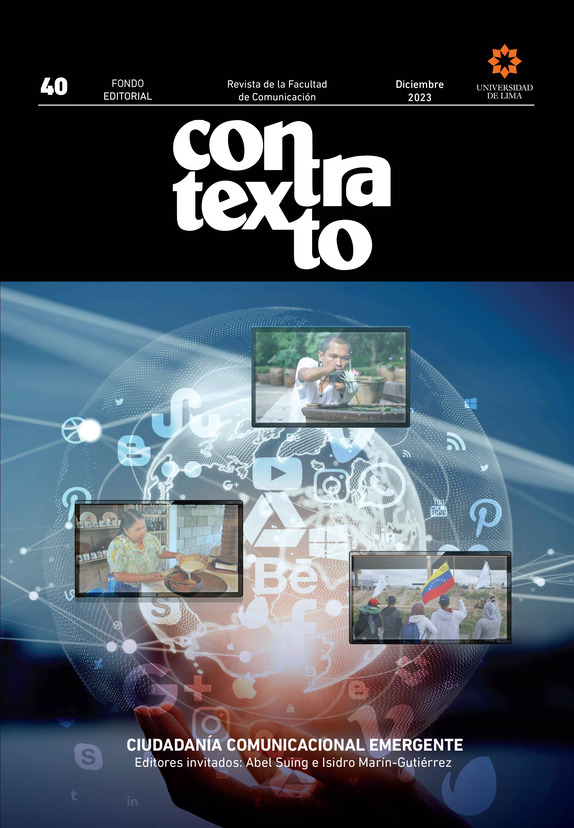El arte en narraciones testimoniales digitales: una herramienta persuasiva en comunicación para la salud
DOI:
https://doi.org/10.26439/contratexto2023.n40.6148Palabras clave:
Narrativas digitales, COVID-19, Persuasión narrativa, Comunicación para la salud, ArteResumen
Esta investigación explora a través de un diseño preexperimental cómo los recursos artísticos pueden ayudar a la prevención en salud. Para ello se desarrolló la página web Diarios de la COVID-19. Allí los participantes (N = 118) llenaron previamente un cuestionario pre-test y, luego de interactuar con cuatro narraciones testimoniales, contestaron el post-test. El estudio investigó el papel del arte en la intención de prevención, percepción y conducta de riesgo, así como la asociación con el transporte narrativo y la identificación con los personajes, los dos mecanismos principales que explican el proceso de la persuasión narrativa. Los resultados demostraron la importancia de incluir recursos artísticos en narraciones para la salud, así como el rol mediador del transporte narrativo y la identificación con los personajes en la percepción de riesgo en crisis sanitarias. Estos resultados son de importancia teórica y metodológica para el funcionamiento de los mecanismos de persuasión narrativa en la investigación de comunicación para la salud a través de narraciones digitales.
Descargas
Referencias
Aaron, R. E., Rinehart, K. L., & Ceballos, N. A. (2011). Arts-based interventions to reduce anxiety levels among college students. Arts & Health, 3(1), 27-38. https://doi.org/10.1080/17533015.2010.481290
Appel, M., Gnambs, T., Richter, T., & Green, M. C. (2015). The transportation scale-short form (TS-SF). Media Psychology, 18(2), 243-266. https://doi.org/10.1080/15213269.2014.987400
Bae, H., Lee, D., & Bae, R. E. (2014). Emotional engagement with plot and characters: A narrative film on hearing-impaired sexual assault victims. Narrative Inquiry, 24(2), 309–327. https://doi.org/10.1075/ni.24.207bae
Battaglia, M. (2008). Nonprobability sampling. En P. Lavrakas (Ed.), Encyclopedia of Survey Research Methods (pp. 524-527). SAGE Publications. https://doi.org/10.4135/9781412963947
Boyd, N. M., & Martin, E. C. (2020). Sense of community responsibility at the forefront of crisis management. Administrative Theory & Praxis, 44(1) 71–83. https://doi.org/10.1080/10841806.2020.1765288
Borrayo, E. A. (2004). Where’s Maria? A video to increase awareness about breast cancer and mammography screening among low-literacy Latinas. Preventive Medicine, 39(1), 99-110. https://doi.org/10.1016/j.ypmed.2004.03.024
Braddock, K., & Dillard, J. P. (2016). Meta-analytic evidence for the persuasive effect of narratives on beliefs, attitudes, intentions, and behaviors. Communication Monographs, 83(4), 446-467. https://doi.org/10.1080/03637751.2015.1128555
Bratitsis, T. (2016). A digital storytelling approach for fostering empathy towards autistic children: Lessons learned. Proceedings of the 7th International Conference on Software Development and Technologies for Enhancing Accessibility and Fighting Info-Exclusion- DSAI. https://doi.org/10.1145/3019943.3019987
Bratitsis, T., & Ziannas, P. (2015). From early childhood to special education: Interactive digital storytelling as a coaching approach for fostering social empathy. Procedia Computer Science, 67, 231-240. https://doi.org/10.1016/j.procs.2015.09.267
Braverman, J. (2008). Testimonials versus informational persuasive messages. Communication Research, 35(5), 666-694. https://doi.org/10.1177/0093650208321785
Busselle, R. W., & Bilandzic, H. (2009). Measuring narrative engagement. Media Psychology, 12(4), 321-347. https://doi.org/10.1080/15213260903287259
Camelo-Guarín, A., González-Cabrera, C. & Vargas-Rosero, E. (2021). El rol de la persuasión narrativa en el Edu-Entretenimiento para mejorar la salud en América Latina: Revisión de los últimos cinco años. Obra Digital, (21), 149-168. https://doi.org/10.25029/od.2021.305.21
Campbell, D. T. & Stanley, J. C. (1966). Experimental and Quasi-Experimental Designs for Research. Rand-McNally.
Costabile, K. A., & Terman, A. W. (2013). Effects of film music on psychological transportation and narrative persuasion. Basic and Applied Social Psychology, 35(3), 316–324. https://doi.org/10.1080/01973533.2013.785398
Davies, C. R., Knuiman, M., Wright, P., & Rosenberg, M. (2014). The art of being healthy: A qualitative study to develop a thematic framework for understanding the relationship between health and the arts. BMJ Open, 4(4), e004790. https://doi.org/10.1136/bmjopen-2014-004790
De Wit, S., Sabin, C. A., Weber, R., Worm, S. W., Reiss, P., Cazanave, C., El-Sadr, W., d’Arminio, A., Fontas, E., Law, M.G., Friis-Møller, N., & Phillips, A. (2008). Incidence and risk Factors for new-onset diabetes in HIV-infected patients. The Data Collection on Adverse Events of Anti-HIV Drugs (D:A:D) Study. Diabetes Care, 31(6), 1224-1229. https://doi.org/10.2337/dc07-2013
Dillard, A. J., & Main, J. L. (2013). Using a health message with a testimonial to motivate colon cancer screening: associations with perceived identification and vividness. Health Education & Behavior: The Official Publication of the Society for Public Health Education, 40(6), 673-682. https://doi.org/10.1177/1090198112473111
Dixon, H. G., Hill, D. J., Borland, R. et al (2001). Public reaction to the portrayal of the tobacco industry in the film The Insider. Tobacco Control, 10(3), 285-291. https://doi.org/10.1136/tc.10.3.285
Dunlop, S., Wakefield, M., & Kashima, Y. (2008). Can you feel it? Negative emotion, risk, and narrative in health communication. Media Psychology, 11(1), 52-75. https://doi.org/10.1080/15213260701853112
Eggeling, M., Bientzle, M., Korger, S., & Kimmerle, J. (2021). The impact of patient narratives on medical students’ perceptions of shared decision making: A randomized controlled trial. Medical education online, 26(1). https://doi.org/10.1080/10872981.2021.1886642
Falzon, C., Radel, R., Cantor, A., & d’ Arripe-Longueville, F. (2015). Understanding narrative effects in physical activity promotion: the influence of breast cancer survivor testimony on exercise beliefs, self-efficacy, and intention in breast cancer patients. Supportive Care in Cancer, 23(3), 761-768. https://doi.org/10.1007/s00520-014-2422-x
Fernández-Aguilar, L., Navarro-Bravo, B., Ricarte, J., Ros, L., & Latorre, J. M. (2019). How effective are films in inducing positive and negative emotional states? A meta-analysis. PloS one, 14(11), e0225040. https://doi.org/10.1371/journal.pone.0225040
Finset, A., Bosworth, H., Butow, P., Gulbrandsen, P., Hulsman, R. L., Pieterse, A. H., Street, R., Tschoetschel, R., & van Weert, J. (2020). Effective health communication – a key factor in fighting the COVID-19 pandemic. Patient Education and Counseling,103(5), 873-876. https://doi.org/10.1016/j.pec.2020.03.027
Green, M. C. (2006). Narratives and cancer communication. Journal of Communication, 56(suppl_1), S163-S183. https://doi.org/10.1111/j.1460-2466.2006.00288.x
Green, M. C., & Brock, T. C. (2000). The role of transportation in the persuasiveness of public narratives. Journal of Personality and Social Psychology, 79(5), 701-721. https://doi.org/10.1037/0022-3514.79.5.701
Green, M. C., & Brock, T. C. (2002). In the mind’s eye: Transportation-imagery model of narrative persuasion. En M. C. Green, J. J. Strange & T. C. Brock (Eds.), Narrative Impact: Social and Cognitive Foundations (pp. 315-341). Lawrence Erlbaum Associates Publishers.
Green, M. C., & Clark, J. L. (2012). Transportation into narrative worlds: implications for entertainment media influences on tobacco use. Addiction, 108(3), 477-484. https://doi.org/10.1111/j.1360-0443.2012.04088.x
González-Cabrera, C., & Igartua, J. J. (2018). Formatos narrativos para la prevención del embarazo. Efecto de la modalidad narrativa en las actitudes de prevención. Revista Latina de Comunicación Social, 73, 1444-1468. https://doi.org/10.4185/RLCS-2018-1316
González-Cabrera, C. (2019). Efectos de la modalidad narrativa en la prevención del embarazo adolescente. Modelos de moderación y de mediación moderada [Tesis doctoral]. Universidad de Salamanca. https://doi.org/10.14201/gredos.140418
Gubrium, A. (2009). Digital storytelling: An emergent method for health promotion research and practice. Health Promotion Practice, 10(2), 186-191. https://doi.org/10.1177/1524839909332600
Hacking, S., Secker, J., Spandler, H., Kent, L., & Shenton, J. (2008). Evaluating the impact of participatory art projects for people with mental health needs. Health & Social Care in the Community, 16(6), 638-648. https://doi.org/10.1111/j.1365-2524.2008.00789.x
Hayes, A. F. (2022). Introduction to Mediation, Moderation, and Conditional Process Analysis: A Regression-Based Approach (3ra ed.). Guilford.
Hernández-Sampieri, R., Fernández Collado, C., & Baptista Lucio, P. (2014). Metodología de la investigación (6a ed.). McGraw-Hill.
Igartua, J. J. (2010). Identification with characters and narrative persuasion through fictional feature films. Communications, 35(4), 347-373. https://doi.org/10.1515/comm.2010.019
Igartua, J. J., & Vega Casanova, J. (2016). Identification with characters, elaboration, and counterarguing in entertainment-education interventions through audiovisual fiction. Journal of Health Communication, 21(3), 293-300. https://doi.org/10.1080/10810730.2015.1064494
Igartua, J. J., & Barrios, I. (2012). Changing real-world beliefs with controversial movies: processes and mechanisms of narrative persuasion. Journal of Communication, 62(3), 514-531. https://doi.org/10.1111/j.1460-2466.2012.01640.x
Igartua, J. J., & Fiuza, D. (2018). Persuading with narratives against gender violence. Effect of similarity with the protagonist on identification and risk-perception. Palabra Clave, 21(2), 499-523. https://doi.org/10.5294/pacla.2018.21.2.10
Igartua, J. J., Guerrero-Martín, I., Cachón-Ramón. D., & Wojcieszak, M. (2021). Mejor te cuento mi historia: vacunas narrativas para reducir el prejuicio hacia inmigrantes. En A. M. Bañón & J. Solves (Eds.), Discurso lingüístico y migraciones (pp. 179-206). Arco/Libros.
Igartua, J. J., González-Vázquez, A., & Arcila-Calderón, C. (2022). Using testimonial narratives to persuade people about artificial intelligence: The role of attitudinal similarity with the protagonist of the message. Profesional de la Información, 31(4), e310409. https://doi.org/10.3145/epi.2022.jul.09
Igartua, J. J., & Cachón-Ramón, D. (2023). Personal narratives for improving attitudes towards stigmatized immigrants: A parallel-serial mediation model. Group Processes & Intergroup Relations, 26(1), 96-119. https://doi.org/10.1177/13684302211052511
Jones, R., Hoover, D. R., & Lacroix, L. J. (2013). A randomized controlled trial of soap opera videos streamed to smartphones to reduce risk of sexually transmitted human immunodeficiency virus (HIV) in young urban African American women. Nursing Outlook, 61(4), 205-215. https://doi.org/10.1016/j.outlook.2013.03.006
Karkou, V., Aithal, S., Zubala, A., & Meekums, B. (2019). Effectiveness of dance movement therapy in the treatment of adults with depression: A systematic review with meta-analyses. Frontiers in Psychology, 10(936). https://doi.org/10.3389/fpsyg.2019.00936
Keer, M., van den Putte, B., de Wit, J., & Neijens, P. (2013). The effects of integrating instrumental and affective arguments in rhetorical and testimonial health messages. Journal of Health Communication, 18(9), 1148-1161. https://doi.org/10.1080/10810730.2013.768730
Kemp, E. (2015). Engaging consumers in esthetic offerings: conceptualizing and developing a measure for arts engagement. International Journal of Nonprofit and Voluntary Sector Marketing, 20(2), 137-148. https://doi.org/10.1002/nvsm.1525
Kreuter, M. W., Green, M., Cappella, J., Slater, M., Wise, M., Storey, D., Clark, E., O’Keefe, D., Erwin, D., Holmes, K., Hinyard, L., Houston, T., & Woolley, S. (2007). Narrative communication in cancer prevention and control: A framework to guide research and application. Annals of Behavioral, 33(3), 221-235. https://doi.org/10.1007/BF02879904
Lee, K. L., Mustaffa, M.S., & Tan, S.Y. (2017). Visual arts in counselling adults with depressive disorders. British Journal of Guidance & Counselling, 45(1), 56-71. https://doi.org/10.1080/03069885.2015.1130797
Love, G. D., Mouttapa, M., & Tanjasiri, S. P. (2009). Everybody’s talking: Using entertainmenteducation video to reduce barriers to discussion of cervical cancer screening among Thai women. Health Education Research, 24(5), 829-838. https://doi.org/10.1093/her/cyp019
McQueen, A., Kreuter, M. W., Kalesan, B., & Alcaraz, K. I. (2011). Understanding narrative effects: The impact of breast cancer survivor stories on message processing, attitudes, and beliefs among African American women. Health Psychology, 30(6), 674-682. https://doi.org/10.1037/a0025395
Mills, C., Knuiman, M., Rosenberg, M., Wood, L., & Ferguson, R. (2011). Are the arts an effective setting for promoting health messages? Perspectives in Public Health, 133(2), 116-121. https://doi.org/10.1177/1757913911419895
Moyer-Gusé, E. (2008). Toward a theory of entertainment persuasion: Explaining the persuasive effects of entertainment-education messages. Communication Theory, 18(3), 407-425. https://doi.org/10.1111/j.1468-2885.2008.00328.x
Moyer-Gusé, E., & Nabi, R. L. (2010). Explaining the effects of narrative in an entertainment television program: Overcoming resistance to persuasion. Human Communication Research, 36(1), 26-52. https://doi.org/10.1111/j.1468-2958.2009.01367.x
Moyer-Gusé, E., Chung, A. H., & Jain, P. (2011). Identification with characters and discussion of taboo topics after exposure to an entertainment narrative about sexual health. Journal of Communication, 61(3), 387-406. https://doi.org/10.1111/j.1460-2466.2011.01551.x
Moyer-Gusé, E., & Dale, K. (2017). Narrative persuasion theories. En P. Rössler & C. A. Hoffner (Eds.), The International Encyclopedia of Media Effects (pp. 1-11). WileyBlackwell. https://doi.org/10.1002/9781118783764.wbieme0082
Murphy, S. T., Frank, L. B., Moran, M. B., & Patnoe-Woodley, P. (2011). Involved, transported, or emotional? Exploring the determinants of change in knowledge, attitudes, and behavior in entertainment-education. Journal of Communication, 61(3), 407-431. https://doi.org/10.1111/j.1460-2466.2011.01554.x
Murphy, S. T., Frank, L. B., Chatterjee, J. S., & Baezconde-Garbanati, L. (2013). Narrative versus nonnarrative: The role of identification, transportation, and emotion in reducing health disparities. Journal of Communication, 63(1), 116-137. https://doi.org/10.1111/jcom.12007
Oh, H. J., & Larose, R. (2015). Tell me a story about healthy snacking and I will follow: Comparing the effectiveness of self-generated versus message-aided implementation intentions on promoting healthy snacking habits among college students. Health Communication, 30, 962-974. https://doi.org/10.1080/10410236.2014.910289
Pérez, M., Sefko, J. A., Ksiazek, D., Golla, B., Casey, C., Margenthaler, J. A., Colditz, G., Kreuter, W. A., & Jeffe, D. B. (2013). A novel intervention using interactive technology and personal narratives to reduce cancer disparities: African American breast cancer survivor stories. Journal of Cancer Survivorship, 8(1), 21-30. https://doi.org/10.1007/s11764-013-0308-4
Phillips-Sheesley, A., Pfeffer, M., & Barish, B. (2016). Comedic improv therapy for the treatment of social anxiety disorder. Journal of Creativity in Mental Health, 11(2), 157-169. https://doi.org/10.1080/15401383.2016.1182880
Reinhart, A. M., Marshall, H. M., Feeley, T. H., & Tutzauer, F. (2007). The persuasive effects of message framing in organ donation: The mediating role of psychological reactance. Communication Monographs, 74(2), 229-255. https://doi.org/10.1080/03637750701397098
Riley, A. H., Sood, S., & Sani, M. (2020). Narrative persuasion and social norms in entertainment-education: Results from a radio drama in Mozambique. Health Communication, 35(8) 1023-1032. https://doi.org/10.1080/10410236.2019.1606137
Robin, B. R. (2008). Digital storytelling: A powerful technology tool for the 21st century classroom. Theory into Practice, 47(3), 220-228. https://doi.org/10.1080/00405840802153916
Roosen, L. J., Klöckner, C. A., & Swim, J. K. (2018). Visual art as a way to communicate climate change: A psychological perspective on climate change-related art. World Art, 8(1), 85-110. https://doi.org/10.1080/21500894.2017.1375002
Sampathirao, P. (2016). Storytelling as a method of health education. Journal of Indian Psychology, 3(2), 32-36. https://doi.org/10.25215/0302.156
Sapouna, L., & Pamer, E. (2016). The transformative potential of the arts in mental health recovery – an Irish research project. Arts & Health, 8(1), 1-12. https://doi.org/10.1080/17533015.2014.957329
Shaffer, V.A., Tomek, S., & Hulsey, L. (2014). The effect of narrative information in a publicly available patient decision aid for early-stage breast cancer. Health Communication, 29(1), 64-73. https://doi.org/10.1080/10410236.2012.717341
Sharan, M., & Valente, T. W. (2002). Spousal communication and family planning adoption: Effects of a radio drama serial in Nepal. International Family Planning Perspectives, 28(1), 16-25. https://doi.org/10.2307/3088271
Shen, F., Sheer, V. C., & Li, R. (2015). Impact of narratives on persuasion in health communication: A meta-analysis. Journal of Advertising, 44(2), 105-113. https://doi.org/10.1080/00913367.2015.1018467
Slater, M. D. (2002). Entertainment education and the persuasive impact of narratives. En M. C. Green, J. J. Strange & T. C. Brock (Eds.), Narrative Impact: Social and Cognitive Foundations (pp. 157-181). Psychology Press. https://doi.org/10.4324/9781410606648
Slater, M. D., & Rouner, D. (2002). Entertainment - education and elaboration likelihood: Understanding the processing of narrative persuasion. Communication Theory, 12(2), 173-191. https://doi.org/10.1111/j.1468-2885.2002.tb00265.x
Slater, M. D., Rouner, D., & Long, M. (2006). Television dramas and support for controversial public policies: Effects and mechanisms. Journal of Communication, 56(2), 235-252. https://doi.org/10.1111/j.1460-2466.2006.00017.x
Strange, J. J., & Leung, C. C. (1999). How anecdotal accounts in news and in fiction can influence judgments of a social problem’s urgency, causes, and cures. Personality and Social Psychology Bulletin, 25(4), 436-449. https://doi.org/10.1177/0146167299025004004
Taylor, V. M., Hislop, G., Jackson, J. C., Shing-Ping, T., Yasui, Y., Schwartz, S. M., Teh, C., Kuniyuki, A., Acorda, E., Marchand, A., & Thompson, B. (2002). A randomized controlled trial of interventions to promote cervical cancer screening among chinese women in North America. Cancer Spectrum Knowledge Environment, 94(9), 670-677. https://doi.org/10.1093/jnci/94.9.670
Ubel, P. A., Jepson, C., & Baron, J. (2001). The inclusion of patient testimonials in decision aids. Medical Decision Making, 21(1), 60-68. https://doi.org/10.1177/0272989x0102100108
Van Laer, T., de Ruyter, K., Visconti, L. M., & Wetzels, M. (2014). The extended transportationimagery model: A meta-analysis of the antecedents and consequences of consumers’ narrative transportation. Journal of Consumer Research, 40(5), 797-817. https://doi.org/10.1086/673383
Van Lith, T., Schofield, M. J., & Fenner, P. (2013). Identifying the evidence-base for art-based practices and their potential benefit for mental health recovery: A critical review. Disability and Rehabilitation, 35(16), 1309-1323. https://doi.org/10.3109/09638288.2012.732188
Ward, M. C., Milligan, C., Rose, E., Elliott, M., & Wainwright, B. R. (2021). The benefits of community-based participatory arts activities for people living with dementia: A thematic scoping review. Arts & Health, 13(3), 213-239. https://doi.org/10.1080/17533015.2020.1781217
Zillmann, D. (2006). Exemplification effects in the promotion of safety and health. Journal of Communication, 56, 221-237. https://doi.org/10.1111/j.1460-2466.2006.00291.x
Zhang, N., & Wen, T. J. (2020). Exploring the public perception of depression: Interplay between the attribution of cause and narrative persuasion. Health Communication, 36(8), 992-1000. https://doi.org/10.1080/10410236.2020.1731775
Publicado
Número
Sección
Licencia
Todos los trabajos publicados están sujetos a una licencia CC BY 4.0 Creative Commons (actualizado el 1 de marzo de 2021).
El contenido de la revista se puede compartir en cualquier material o formato. Asimismo, se puede adaptar, contribuir y transformar. Ambas posibilidades sólo están permitidas en la medida en que cumplan las siguientes condiciones:
- Atribución: Se debe otorgar crédito donde sea debido, proporcionar un enlace a la licencia e indicar los cambios en caso se realice alguno. Esto debe hacerse de la manera que se considere apropiada, sin sugerir que el licenciante lo promueva a usted o su uso del material.
Derechos de propiedad
Los derechos patrimoniales de Contratexto se publican bajo una licencia Creative Commons BY 4.0, lo que permite a los autores mantener los derechos patrimoniales de su obra sin restricciones.
Si un trabajo publicado en Contratexto fuera copiado, distribuido, difundido o cualquier otra actividad contemplada en la licencia antes mencionada, se deberá mencionar de manera visible y expresa al autor o autores y a la revista.
Auto-archivo
Esta revista permite y anima a los autores/as a publicar artículos enviados a la revista en sus sitios web personales o en depósitos institucionales, tanto antes como después de su publicación en esta revista, siempre y cuando proporcionen información bibliográfica que acredite, si procede, su publicación en ella.


















